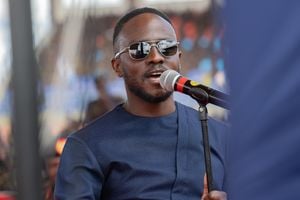PNU revival to complicate vote math in fractious Mt Kenya region
What you need to know:
Industrialisation CS Peter Munya, all but in name emerged a significant player in the Kenyatta succession politics in the region.
Many tell-tale signs were on display that a new kid had arrived on the block, going by the largely “orderly” organisation and process supervised by Registrar of Political Parties Ann Nderitu.
more than 5,000 delegates trucked and bussed to the stadium at a steep cost, and the list of guests and speakers.
The return of Party of National Unity (PNU) to the mainstream politics in Mt Kenya region brings back memories of the 1992 split of the presidential vote between two titans — Kenneth Matiba of Ford-Asili, who has since died — and retired President Mwai Kibaki of the Democratic Party.
DEMOGRAPHICALLY
In that year’s presidential poll, retired President Moi scraped his way back to office with 1,927,645 votes (36.6 per cent) against Matiba’s 1,354,856 (25.7 per cent) and Kibaki’s 1,035,507 (19.6 per cent).
The third opposition presidential candidate Jaramogi Oginga Odinga, who died in 1994, garnered 903,886 of the vote (17.1 per cent), bringing the combined opposition voter-basket to over 3 million ballots.
However, it was the split of the usually solid Gema voting bloc that was most decisive at the national level in aiding President Moi’s re-election in 1992, composition and performance of the National Assembly, not to mention leadership of the local authorities, especially the politically significant Nairobi County (then Nairobi City Council) and Nakuru Municipality, whose leadership became mad houses of intrigues between DP and Ford-Asili men.
At the regional level, the Nyeri, Kirinyaga, Embu, Laikipia and Meru counties (then districts) stuck with Kibaki’s DP, while Murang’a, Kiambu and Nakuru stuck with Matiba’s Ford-Asili. They split the Nairobi and Nyandarua votes and elective positions between them.
It’s noteworthy that pockets of Mt Kenya that are geographically marginal and demographically perceived as minorities — Mbeere in Embu county, Tigania and Igembe in Meru county and Tharaka stuck with Moi’s Kanu for most of the decade opposition politics dominated the region (1992-2002) until 2002 when the united opposition forces routed Kanu.
BENEFACTORS
This historical experience is important in reading the events at Kasarani Sports Stadium, where Industrialisation CS Peter Munya, all but in name emerged a significant player in the Kenyatta succession politics in the region.
Many tell-tale signs were on display that a new kid had arrived on the block, going by the largely “orderly” organisation and process supervised by Registrar of Political Parties Ann Nderitu, more than 5,000 delegates trucked and bussed to the stadium at a steep cost, and the list of guests and speakers.
Organisers were not forthcoming with exact figures, but one put it this way when asked how much it cost planners in delegates allowances and other logistical overheads: “Lets say between Sh5,000 and Sh10,000 depending on how far one had travelled to get to Nairobi,” he said. Even if one used a flat figure of Sh5,000 a delegate, 5,000 delegates would translate to Sh25 million.
Reports that some Sh41 million bank loan for PNU headquarters on Church Road had been settled by unnamed benefactors ahead of the national delegates conference that elected the first substantive National Executive Council (NEC) office bearers since in 2009, puts the estimated bill for the event at Sh66 million at least.
This lends credence to speculations about involvement of powerful forces behind the revival of PNU, including highly placed political and state functionaries in footing the hefty bill.
Mr Munya said he attended “as an elder”, but his known associates and allies took the lions share of the top positions, effectively vanquishing his perennial rival for control of PNU, Mr John Kamama.
Munya was accompanied by Laikipia Governor Nderitu Muriithi, who also addressed the delegates as a “a friend of PNU”.
MACHINERY
PNU chairmanship, vice chairmanship, and the secretary-general post went to staunch Munya political acolytes, David Kamau, Cpt (rtd) Paul Rukaria and John Anunda respectively, effectively putting his line-up firmly in charge of the PNU.
Mr Kamama secured the organising secretary post, while his allies Alphonse Musyoki, Kelvin Kariuki and Paul Amenya took treasurer, deputy secretary-general and second vice-chairperson respectively.
By dint of being a pensioner on State stipends for retired presidents, retired President Mwai Kibaki is assumed to have relinquished his party leader’s position he assumed in 2009.
However, the party leaders’ position was left “unchanged” and unfilled, implying Kibaki was till legal party leader, though it is assumed to be reserved for Munya.
Retired presidents and other constitutional office holders are required to resign their political offices before they can collect their pension cheques.
However, for a serving CS to overtly participate in such an explicit political event is unthinkable, without a tacit wink from high up, not to mention the backroom supportive role played by certain sections of the establishment machinery.
It remains to be seen how the majority voting bloc in Meru county, the Imenti and the rest of the Gema household is likely react to the apparent subtle elevation of Mr Munya and PNU by the establishment.




